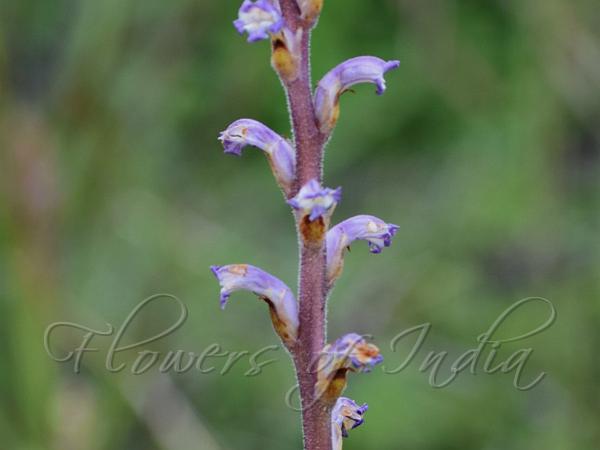|
| Sunflower Broomrape |
|

|

| File size | 134697 |
| Original date | 10/1/21 4:39 PM |
| Resolution | x |
| Flash | Flash did not fire, auto |
| Focal length | 90.0mm |
| Exposure time | 1/125s |
| Aperture | 8.0 |
| Focus Distance | |
| Metering Mode | $meteringMode |
| Camera make | NIKON CORPORATION |
| Camera model | NIKON D5300 |
| Sensor type |
|
|
|
|
Photo: |
Botanical name: Orobanche cumana Family: Orobanchaceae (Broomrape family)
Synonyms: Orobanche cernua subsp. cumana
Synonyms: Orobanche cernua subsp. cumana
Sunflower Broomrape is an obligatory, root parasitic
plant that produces leafless flowering stems 40-60 cm high bearing
alternate scales less than 1 cm long. It is mostly parasitic on the
roots of Artemisia and Sunflower plants. Although usually unbranched
above ground, multiple stems sometimes arise from a single tubercle
below ground. The plant is pale, completely lacking any chlorophyll.
The base of the stem, below ground, is normally swollen and tuberous.
The inflorescence, occupying up to half the length of the stems carries
many acropetally developing flowers, arranged in spikes or racemes,
each subtended by a bract 7-12 mm long (without the additional
bracteoles present in O. ramosa). The sepal-cup has four free sepals,
more-or-less bitoothed, 7-12 mm long. The white flower tube, 2-3 cm
long, is inflated near the base, prominently down-curved, with narrow
reflexed lips, up to 1 cm across. The tube is mainly white or pale
while the lips are contrastingly blue or purple, without distinct
venation. Filaments are inserted in the flower tube, 4-6 mm above the
base. A capsule develops up to 8-10 mm long and may contain several
hundred seeds. A single plant carries 10-100 flowers and hence may
produce over 100,000 seeds. Sunflower Broomrape is native to E. Europe
to S. Siberia, W. & N. China, and Western Himalaya. Flowering:
April-May.
| Identification credit: Oscar Sanchez Pedraja, Ashutosh Sharma | Photographed in Kullu Valley, Himachal Pradesh. |
• Is this flower misidentified? If yes,